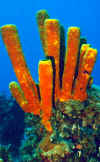Porifera
Reminder: Clicking on the picture will take you to the site where I originally found it.
 The phylum to which all sponges belong is called Porifera. This name means that the animal containes pores or holes. This is a pretty good description of a sponge.
The phylum to which all sponges belong is called Porifera. This name means that the animal containes pores or holes. This is a pretty good description of a sponge.
Sponges are about as simple an animal as you can find. Sponges function almost as a colony of cells which work together to stay alive.
The simplest sponges are basically hollow tubes. A sponge has no mouth, but it can move water through its pores with the help of special cells. The water goes in through the pores and tiny bits of food get trapped in the sponge. The food particles are enveloped by individual cells, nourishing the sponge. To get rid of waste products and extra water, the sponge pumps it out a large hole, usually in the top of the sponge.
 There are three body-types for sponges. The most simple is a single hollow tube. It never grows large or massive. This is an asconoid sponge. As sponges grew thicker, they needed canals to help the nutrients reach througout the sponge. This tupe of sponge tents to be larger and is called a syconoid sponge. The most complex type of sponge has a whole network of canals. They usually have many large holes and canals and are called leuconoid sponges. This last type are most common.
There are three body-types for sponges. The most simple is a single hollow tube. It never grows large or massive. This is an asconoid sponge. As sponges grew thicker, they needed canals to help the nutrients reach througout the sponge. This tupe of sponge tents to be larger and is called a syconoid sponge. The most complex type of sponge has a whole network of canals. They usually have many large holes and canals and are called leuconoid sponges. This last type are most common.
Occasionally you'll see a dry sponge for sale somewhere. This is not the living cells, but the skeleton of the sponge. The living portions die when the sponge is dried. And, just for your information, a loofah sponge isn't a sponge at all. It's plant fiber.
All the way back to the animal page,
near the cnidarians,
meet the mollusks,
advance to the arthropods,
enquire about the echinoderms,
wade through the worms,
commune with the chordates or
over to the overview.
 The phylum to which all sponges belong is called Porifera. This name means that the animal containes pores or holes. This is a pretty good description of a sponge.
The phylum to which all sponges belong is called Porifera. This name means that the animal containes pores or holes. This is a pretty good description of a sponge. There are three body-types for sponges. The most simple is a single hollow tube. It never grows large or massive. This is an asconoid sponge. As sponges grew thicker, they needed canals to help the nutrients reach througout the sponge. This tupe of sponge tents to be larger and is called a syconoid sponge. The most complex type of sponge has a whole network of canals. They usually have many large holes and canals and are called leuconoid sponges. This last type are most common.
There are three body-types for sponges. The most simple is a single hollow tube. It never grows large or massive. This is an asconoid sponge. As sponges grew thicker, they needed canals to help the nutrients reach througout the sponge. This tupe of sponge tents to be larger and is called a syconoid sponge. The most complex type of sponge has a whole network of canals. They usually have many large holes and canals and are called leuconoid sponges. This last type are most common.